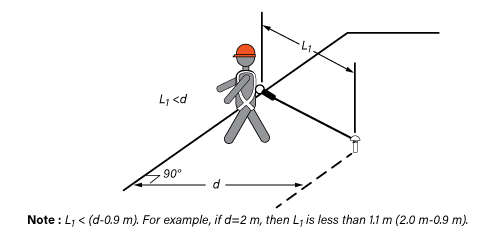Fall Protection - Travel Restraint System
On this page
When do you use a travel restraint system?
Back to topWhen the fall hazard or working at heights cannot be eliminated, and you cannot use a guardrail or opening cover to protect against a fall, then one option is to use a travel restraint system. A travel restraint system restricts the worker's movements in the fall hazard area by allowing them to reach the edge, but they are not able to fall over the edge. Travel restraint is used for leading edge work where there is an unprotected end of formwork, floors, roofs, decks or other walking or working surfaces.
Using a travel restraint system is part of a fall protection program. Please also see the following OSH Answers for more information:
What is included in a travel restraint system?
Back to topA travel restraint system consists of (equipment or item must be CSA approved, where required):
- Full body harness (class A)
- Lanyard (fixed length or adjustable)
- Lifeline
- Rope grab to attach the lanyard to the lifeline
- Adequate anchorage connectors and anchorage capable of supporting a load as determined by the jurisdiction. For example, a load of 4 kilonewton (kN) – this figure includes a static load of 2 kN or 450 pounds with a recommended safety factor of at least 2, therefore, 4kN or 900 pounds (force). CSA Z259.17-21 Selection and use of active fall-protection equipment and systems states a minimum of 3.6 kN or 800 pounds (force) for a temporary travel restraint set up having no free fall, and for use by one worker.
What should be done before using a travel restraint system?
Back to topThe use of a travel restraint system must be thoroughly planned. Always do the following before using a travel restraint system:
- Identify all fall hazards in the work area. Plan for irregular (non-uniform) shaped areas or perimeters, surface openings, or locations near corners that may impact the range of travel.
- Select appropriate components such as carabiner, snap hook, Y-lanyard, energy absorbers, lifeline, and self-retracting life line.
- Locate suitable anchor points. Select an anchor point that is as close as possible to being perpendicular to the unprotected edge, and at the centre of the work area.
- Have a competent person inspect the travel restraint system thoroughly before (and after) use. If any part of the travel restraint system is defective, the component must be taken out of service immediately.
Note that if a travel-restraint system does not prevent a worker from reaching the edge (fall hazard), a fall-arrest system must be used.
What should be done when using a travel restraint system?
Back to top- Adjust your connections to the anchor or change anchors – It may not be appropriate to use a lifeline or lanyard with the same length if you are working in different work areas. Adjust your connection to the anchor or change anchors to provide travel restraint for each work area.
When changing your anchor points, always use the Y-lanyard which ensures the worker is tied off 100% of the time. When using the Y-lanyard, one connector is always connected to a fall protection anchorage, while the other can be attached to a new location to allow the worker to change location and remain tied-off.
- Adjust the system – Adjust the system so that the connection between the worker and the anchor when fully extended prevents the worker from reaching any point where the worker may fall.
- Be aware of sharp edges – The sharp edges cause damage to the lifeline or lanyard, including a self-retracting lifeline or lanyard as it hits and rubs against the edge. If that happens and if a worker fell, the force of stopping the fall would likely cause the lifeline or lanyard to break.

Figure 1: Travel restraint situations – single anchor. From: CSA Z259.17-21 Selection and use of active fall-protection equipment and systems
- Fact sheet last revised: 2023-01-13
